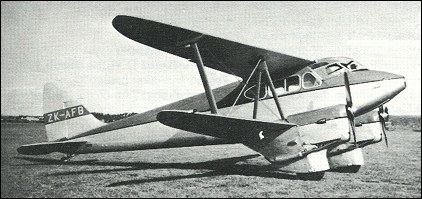|
| The external similarity between the de
Havilland D.H.90 Dragonfly and the
D.H.89 Dragon Rapide belied its very different
internal structure, the earlier design's
spruce and plywood box fuselage
being replaced by a pre-formed plywood
monocoque shell strengthened with
spruce stringers. The lower wing centresection
was strengthened, making possible
deletion of the nacelle/wing root
bracing struts and inner bay rigging
wires, and so providing easy access to
the cabin, with its accommodation for a
pilot and four passengers. Powered by
two de Havilland Gipsy Major engines,
the prototype made its first flight at Hatfield
on 12 August 1935 and the first
D.H.90A production aircraft, with
Gipsy Major II engines, flew in February
1936. Production totalled 66 Dragonfiies,
the type being popular initially with the
prominent private owners of the time,
both in the UK and abroad, but most
were used eventually for commercial
purposes. Military purchasers included
Canada, Denmark and Sweden.
| MODEL | D.H.90 |
| ENGINE | 2 x de Havilland Gipsy Major inline piston engines, 97kW |
| WEIGHTS |
| Take-off weight | 1814 kg | 3999 lb |
| Empty weight | 1134 kg | 2500 lb |
| DIMENSIONS |
| Wingspan | 13.11 m | 43 ft 0 in |
| Length | 9.65 m | 32 ft 8 in |
| Height | 2.79 m | 9 ft 2 in |
| Wing area | 23.78 m2 | 255.97 sq ft |
| PERFORMANCE |
| Max. speed | 232 km/h | 144 mph |
| Cruise speed | 201 km/h | 125 mph |
| Ceiling | 5515 m | 18100 ft |
| Range | 1006 km | 625 miles |
 | A three-view drawing (700 x 648) |
| Stan Svihla, e-mail, 28.10.2011 03:22 I had my first flight in a Dragonfly registered CF-BFF on Fairchild floats. It operated out of Rouyn-Noranda for Gold Belt Air Service after purchased from de-Havilland Canada. The flight was arranged by the Canadian Air Cadets of which I was a member. Imagine my surprise 6 years later when I was employed by de-Havilland to see CF-BFF on floats gracing many office walls at the plant. Like all de-Havilland passenger designs it was an attractive looking aircraft with nice lines for a twin-engined bi-plane. Some considered it to be the first of a line what was to become executive and personal type of aircraft. A pilot and four passengers plus baggage in very comfortable accommodations. Sadly,a number of years later during a flight CF-BFF was a victim of icing
and crashed and burned with the remains still in the bush when last mentioned in news. reply | | David Wilson, e-mail, 31.07.2011 14:57 Chris,
My father and I used to fly the aircraft at Manchester(Ringway as it was known then). It was not a Dragonfly, but a DH-89A Dragon Rapide, owned by Airviews Ltd. of Manchester.
The Rapide had 12 seats, the Dragonfly only carried 4 passengers. reply | | peter hunter, e-mail, 05.10.2010 23:00 this aircraft is alsow a key fighter and bomber reply | | Chris Pownall, e-mail, 16.08.2010 10:38 My mother to me to Manchester airport in the 1950's for a pleasure flight aboard a De Havilland Dragonfly. I beieve it had 11 passenger seats. Can you please confirm seat numbers. Thanks reply |
|
Do you have any comments?
|
| 
COMPANY
PROFILE
All the World's Rotorcraft
|








